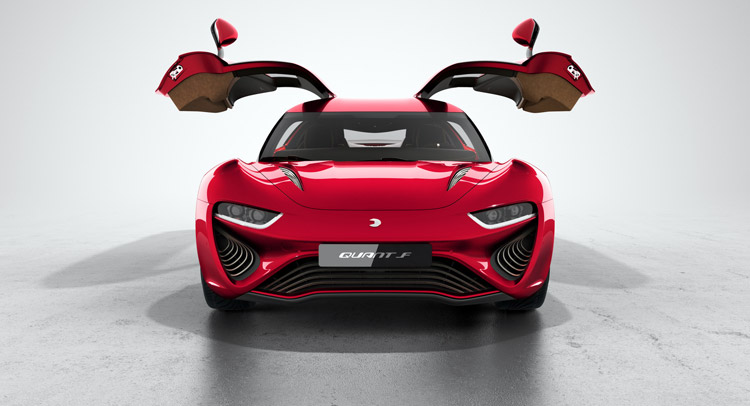After introducing us to the Quant e-Sportlimousine at the 2014 Geneva Motor Show, NanoFlowcell is now heading to this year’s event with the redesigned Quant F.
Set for a world premiere at the 2015 Geneva auto show on March 3, the Quant F is said to be a “completely re-engineered and re-designed” version of the Quant E, though admittedly, you’ll have a hard time telling the two apart just by looking at the pictures.
The only visible differences on the outside include the different color scheme, the bigger door mirrors, the wheel design and the new headlamp fixtures that contain back-lit crystals that project a “Q” for QUANT when switched on.
The Quant F continues to feature two gigantic gullwing doors that open up to reveal space for four passengers, with the car being longer than a Mercedes-Benz S-Class LWB at 5,257mm (207 inches).
According to the Lichtenstein-based company, the newly developed monocoque made of carbon fibre with a narrower A-pillar provides the car with “a more spacious interior”.
NanoFlowcell says it has updated the Quant F’s all-electric powertrain with a new 2-speed automatic transmission developed in-house, “the likes of which has not existed to date”. The transmission works with four improved electric motors, one for each wheels, producing up to 1,090PS or 1,075hp for a limited time, a notable increase over the previous model’s 925PS or 912hp.
“With the QUANT F we are currently able to attain peak output of 1090 PS/801.69 kW for a limited duration and a maximum rated voltage of 735 V (previously 600 V),” explains the firm”s Chief Technical Officer Nunzio La Vecchia.
“This represents a massive increase for an electric vehicle. In this connection, I would expressly like to point out that we researchers are not interested here in pumping up PS/kW figures, but rather in realising what is technically feasible. For both technical and economic reasons, the rated voltage for normal operation of the QUANT F will stand at approximately 400 V in future. This enables efficient and economical driving and means correspondingly greater ranges accompanied by outstanding performance with zero harmful emissions,” he added.
The four motors offer the Quant F permanent 4×4 all-wheel drive, though it can be converted automatically into rear-wheel drive during high speeds or acceleration, with the front axle “declutching” and running in idling mode.
Electric power is provided by the firm’s own flow cell battery storage tech that works “like a combination of a battery and a fuel cell using liquid electrolytes”.
“Instead of using hydrogen and oxygen as in a conventional fuel cell, we work with two ionic fluids – one with a positive charge and one with a negative charge,” explains Nunzio La Vecchia.
“With a total tank capacity of 500 liters, comprising two times 250 liters in two tanks accommodated separately in the QUANT’s substructure, in the space of only nine months we have achieved an increase in range of over 30 percent in comparison to the QUANT E from 2014,” he said.
According to nanoFlowcell, the Quant F’s exterior is 100 percent compatible with homologation requirements, while the interior is over 90 percent ready for production.
“Homologation requirements currently still require to be met with regard to the font display, the airbags, the complex crash tests and formal tests and documentation,” said Nunzio La Vecchia. “The crash tests are to be carried out in the USA and in Germany. Though I must say the idea of putting such a fascinating car through a crash test really grates on me.”









